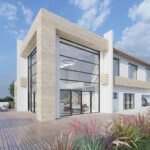Sustainability has become a cornerstone of modern architecture, especially in regions like Paphos, where preserving the natural beauty and resources is crucial. Maze Architecture, a leading architectural firm in Paphos, is at the forefront of integrating sustainable design principles into its projects. This commitment not only enhances the environmental friendliness of their buildings but also ensures long-term benefits for the community and the environment.
Understanding Sustainable Architecture
Sustainable architecture involves designing and constructing buildings in a way that reduces their environmental impact. This includes using eco-friendly materials, improving energy efficiency, and incorporating renewable energy sources. Maze Architecture employs these principles across all its projects, striving to create buildings that are both beautiful and sustainable.
Key Sustainable Practices at Maze Architecture
- Energy Efficiency
One of the primary focuses at Maze Architecture is energy efficiency. The firm incorporates several strategies to reduce energy consumption in buildings:
- Insulation and Thermal Mass: Proper insulation and the use of materials with high thermal mass help regulate indoor temperatures, reducing the need for heating and cooling systems.
- Passive Solar Design: Buildings are oriented and designed to maximize natural light and heat from the sun during the winter while minimizing overheating during the summer. This reduces reliance on artificial lighting and climate control systems.
- High-Performance Windows and Glazing: The use of energy-efficient windows and glazing techniques further enhances thermal insulation, preventing heat loss in winter and heat gain in summer.
- Use of Renewable Energy
Maze Architecture actively integrates renewable energy solutions into its designs:
- Solar Panels: Many of their projects feature solar panels, providing a clean and renewable energy source that significantly cuts down on electricity costs and carbon footprint.
- Solar Water Heating Systems: Solar thermal systems are often used for water heating, reducing the need for conventional water heating systems that rely on electricity or gas.
- Sustainable Materials
The choice of building materials plays a crucial role in sustainable architecture. Maze Architecture prioritizes materials that have a lower environmental impact:
- Locally Sourced Materials: Using local materials reduces transportation emissions and supports the local economy. Limestone, a common building material in Cyprus, is frequently used for its availability and durability.
- Recycled and Reclaimed Materials: Incorporating recycled steel, reclaimed wood, and other materials not only reduces waste but also adds a unique character to the buildings.
- Eco-Friendly Finishes: The firm uses paints, sealants, and finishes that are low in volatile organic compounds (VOCs), ensuring healthier indoor air quality.
- Water Conservation
Water conservation is another critical aspect of Maze Architecture’s sustainable design approach:
- Rainwater Harvesting: Systems for collecting and storing rainwater are often integrated into the designs, providing water for irrigation and reducing the demand on municipal water supplies.
- Greywater Recycling: Some projects include systems that recycle greywater (wastewater from baths, sinks, etc.) for use in landscaping, reducing freshwater usage.
- Green Spaces and Biodiversity
Incorporating green spaces and promoting biodiversity is a key feature in Maze Architecture’s projects:
- Green Roofs and Walls: These are used not only for their aesthetic appeal but also for their environmental benefits, such as reducing heat islands and supporting local biodiversity.
- Native Landscaping: Landscaping with native plants reduces water usage and provides habitats for local wildlife.
Benefits of Sustainable Design
The sustainable design principles employed by Maze Architecture provide numerous benefits:
- Environmental Impact: Reducing the carbon footprint and preserving natural resources.
- Economic Savings: Lower energy and water costs over the building’s lifecycle.
- Health and Wellbeing: Improved indoor air quality and natural lighting contribute to the well-being of occupants.
- Resilience: Buildings designed with sustainability in mind are often more resilient to environmental challenges, such as extreme weather conditions.
Conclusion
Maze Architecture’s commitment to sustainable design is evident in its thoughtful and innovative approaches to building in Paphos. By integrating energy-efficient systems, renewable energy, sustainable materials, and water conservation techniques, Maze Architecture not only enhances the environmental performance of its buildings but also contributes to a more sustainable future for the region. For clients seeking to create beautiful, functional, and eco-friendly spaces, Maze Architecture offers a comprehensive and forward-thinking solution.







